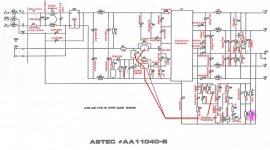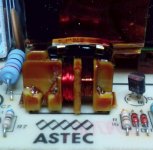Ian,
Here is a bit of information on the A2E Power Supply.
https://ia801002.us.archive.org/1/items/Astec_Power_Supplies_Aug82/Astec_Power_Supplies_Aug82.pdf
https://www.applefritter.com/conten...chirping-and-gives-fluctuating-voltage-output
I also have saved this from the Model 3 Manual for the Astec Power Supply that is in the TRS-80 Model 3.
ASTEC TRS-80 Model 3 Power Supply
NOTE: Use an isolation transformer when servicing the power supply.
Disconnect Connectors SK2, SK3, and SK4 to
avoid possible damage to the Computer from high voltages
that may be produced while servicing the power supply.
Power Supply Load Values:
.................+5.....................+12................-12
min.............45A..................3A..................0A
Safe............11.11 OHM........40 OHM.........0
PWR...........5 Watts.............8 Watts..........0
MAX............2.5A.................2.02A............1A
PWR............2 OHMS..........24.24 OHM......120 OHM
Safe PWR....25 Watts..........50 Watts.........2 Watts
Use a 60 Watt Incandescent Light Bulb in Series with the Line (HOT)
to protect from a possible shorted Supply. If there is a defect
the Light Bulb will "Shine Bright", or if there is a problem it may
be half bright, depending on the malfunction.
REF: Model 3 Service Manual
Check Fuse Resistor R25. If R25 is open check for shorts at
the Bridge Rectifier (DB1). Check for a possible shorted
Driver Transistor (Q2). If R25 is good apply 120V AC power
and check for 120V AC across capacitor C2. If 120 AC is
missing check the Line Choke (L1), Power Switch (SW1) and
check connector SK1 for good connections & Safe LOADS. If
120V AC is present at Capacitor C2, check for 163V at cathode
of Diode D2 (use emitter of Oscillator Transistor Q1 as
reference). If 163V is missing, check Bridge Rectifier
(DB1). If 163V is present, check the waveforms at the base
of oscillator Transistor (Q1) and Driver Transistor (Q2) to
determine if the power supply is oscillating. If the power
supply is not oscillating check the voltages and com-
ponents associated with Transistors Q1 and Q2, check
Diodes D1, D2, and D3 and check for possible open windings
on Transformers T1 and T2. If the power supply is
oscillating, check the source voltages at connector SK2
(-12.8V at Pin P1, 12.0V at Pin P2 and 5.0V at pin P4). If the
voltages are not regulated, check the voltages and comp-
onents associated with the Regulator IC (IC1) and
Regulator Transistor (Q3). Check Transformer T1 for poss-
ible open windings. If the 12V source is missing, check
Diode D4, Coil L4, Electrolytics C11 and C15 and check the
windings from Pin 7 to Pin 9 of Transformer T2. If the -12.8V
source is missing, check Diode D7, Coil L6, Electrolytics
C14 and C16, and check the windings from pin 6 to 8 of Trans-
former T2.
Larry




